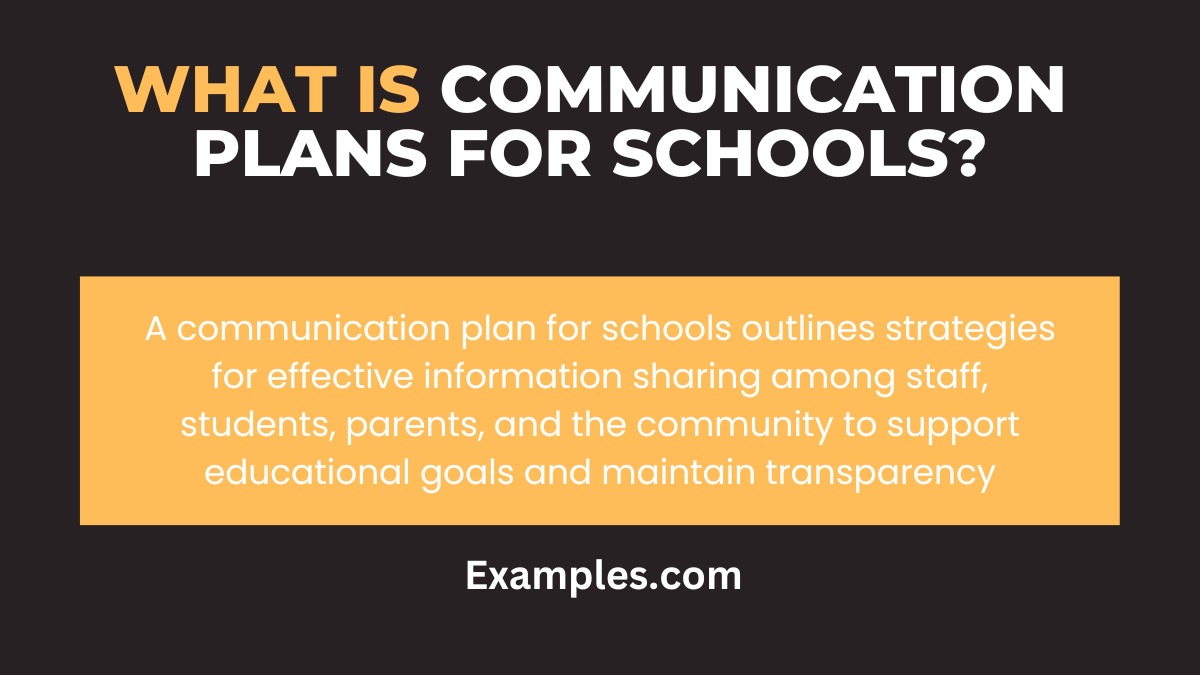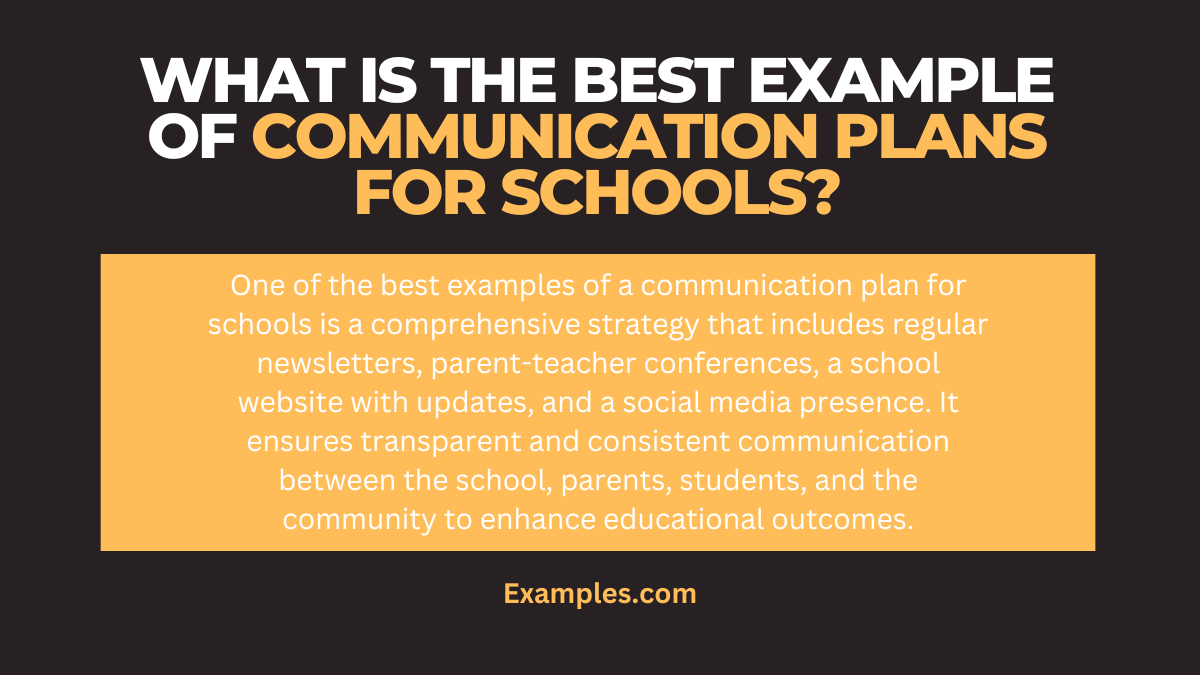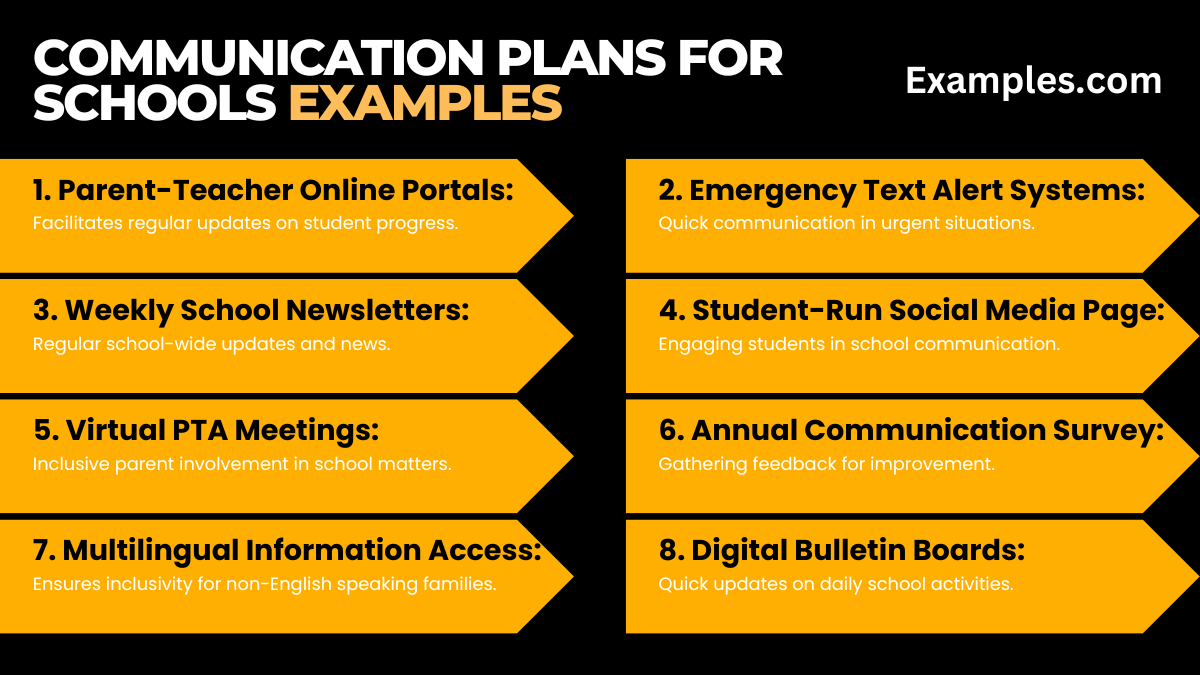19+ Communication Plans for Schools Examples
In the dynamic world of education, effective communication is pivotal. This guide explores the intricacies of Communication Plans for Schools, providing diverse communication examples from classroom settings to school-wide announcements. It delves into strategies for enhancing teacher-student interactions, improving parent-teacher relationships, and utilizing digital platforms for efficient school communication. With practical examples and solutions, this guide is an invaluable resource for educators aiming to foster a more engaged and informed educational community.
Download School Communication Planning Guide PDF
What is Communication Plans for Schools?

Communication Plans for Schools are strategic frameworks designed to streamline and optimize the flow of information within educational settings. They encompass various methods and channels for effectively sharing information among students, teachers, staff, and parents. The focus is on ensuring clear, consistent, and timely communication to support educational goals, enhance student engagement, and maintain an informed school community. These plans often include protocols for regular updates, emergency communications, and avenues for feedback communication skills.
What is the best Example of Communication Plans for Schools?

A prime example of a Communication Plan for Schools is seen in a comprehensive digital communication strategy. This plan typically involves integrating a variety of digital platforms, such as school websites, email systems, and educational apps, to facilitate effective communication. It ensures real-time updates regarding school events, curriculum changes, and emergency alerts, directly reaching students, parents, and staff. Additionally, the plan incorporates feedback mechanisms, allowing for an interactive and responsive communication environment within the educational community. This approach significantly enhances the efficiency and reach of school communications, fostering a more connected and informed educational setting.
20 Communication Plans for Schools Examples

Creating effective Communication Plans for Schools involves diverse strategies to address various educational communication objective needs. These plans are designed to enhance interaction between students, teachers, parents, and school administration. They focus on clarity, timeliness, and inclusivity in sharing school-related information, updates, and emergency alerts. Incorporating digital tools, maintaining open feedback channels, and ensuring transparency are key components.
- Parent-Teacher Online Portals
- Facilitates regular updates on student progress.
- Emergency Text Alert Systems
- Quick communication in urgent situations.
- Weekly School Newsletters
- Regular school-wide updates and news.
- Student-Run Social Media Pages
- Engaging students in school communication.
- Virtual PTA Meetings
- Inclusive parent involvement in school matters.
- Annual Communication Surveys
- Gathering feedback for improvement.
- Multilingual Information Access
- Ensures inclusivity for non-English speaking families.
- Digital Bulletin Boards
- Quick updates on daily school activities.
- Teacher Blogs
- Personal insights into classroom experiences.
- Online Homework Platforms
- Streamlines assignment communication.
- Mobile Apps for School Updates
- Convenient access to school information.
- Email Campaigns for Event Promotion
- Effective tool for event awareness.
- Video Messages from School Leadership
- Personalized updates from administrators.
- Interactive School Calendars
- Keeps everyone informed about upcoming events.
- Peer Mentorship Communication Channels
- Support for new students.
- Health and Safety Protocol Updates
- Critical updates on wellbeing measures.
- Alumni Engagement Platforms
- Maintains connection with former students.
- Community Partnership Announcements
- Information on collaborative initiatives.
- Student Council Communication Forums
- Student leadership engagement.
- Guidance Counseling Availability Notifications
- Updates on support services for students.
Communication Plan in School at Workplace
Communication Skills Workplace plans in school focus on fostering clear, efficient dialogue among staff, teachers, and administration. These plans often include regular staff meetings, internal newsletters, and digital communication tools, enhancing overall workplace coordination and fostering a collaborative educational environment.
- Staff Meeting Agendas:
- Streamlines meeting focus.
- “Today’s staff meeting will cover the upcoming school event planning.”
- Internal Teacher Forums:
- Platform for sharing resources.
- “Check our forum for new teaching materials shared by colleagues.”
- Administration Email Updates:
- Keeps staff informed about administrative decisions.
- “Please read the latest policy changes emailed by the principal.”
Communication Plans for School Activities
Communication plans for school activities are designed to effectively organize and disseminate information regarding various school events and programs. They typically involve the use of digital newsletters, social media updates, and permission slips to ensure parents and students are well-informed and engaged.
- Activity Announcement Flyers:
- Spreads the word about upcoming activities.
- “Join our annual science fair next month, details on the flyer!”
- Online Permission Slips:
- Streamlines process for activity approvals.
- “Please complete the online permission slip for the field trip.”
Crisis Communication Plan for Schools
Crisis communication plans for schools outline protocols for handling emergencies and unexpected situations. These plans prioritize student safety, ensuring rapid and clear communication with parents, staff, and emergency services during critical incidents.
- Emergency Contact Systems:
- Quickly informs parents during emergencies.
- “In case of an emergency, we will immediately notify parents via our automated system.”
- Drill Procedure Updates:
- Keeps the school community informed about safety drills.
- “Reminder: We will conduct a fire drill next week, please review the procedures
How to Create Your School’s Communication Plan?
Creating an effective communication plan for your school involves several key steps:
- Assess Current Communication Needs: Identify the areas where your school’s communication could be improved.
- Define Your Goals: Clearly articulate what you aim to achieve with your communication plan.
- Identify Your Audience: Understand who needs to receive your communications, such as students, parents, staff, and the community.
- Choose Appropriate Channels: Select the most effective methods for communicating, like newsletters, emails, social media, or school apps.
- Develop a Content Strategy: Plan what type of information needs to be communicated regularly.
- Establish a Timeline: Create a schedule for when and how often communications will be sent out.
- Implement the Plan: Start executing your communication strategies.
- Evaluate and Adjust: Regularly review the effectiveness of your communications and make adjustments as needed.
Tips to Build an Effective School Communication Plan
To build an effective School Communication Plan, consider these key tips:
- Understand Your Audience: Identify the different groups you need to communicate with, such as students, parents, teachers, and staff.
- Set Clear Objectives: Define what your communication plan aims to achieve, like improving parent engagement or streamlining internal communications.
- Choose Appropriate Channels: Select the most effective communication channels for your audience, like email, social media, or school portals.
- Regularly Update and Inform: Keep your school community informed with regular updates about school activities, events, and policies.
- Encourage Two-Way Communication: Foster an environment where feedback is encouraged and valued.
- Be Consistent and Clear: Ensure your messages are consistent, clear, and align with your school’s values and policies.
- Plan for Crises: Develop a crisis communication plan to handle emergencies effectively.
- Train Your Team: Provide training for staff on effective communication skills practices.
- Evaluate and Adapt: Regularly review the effectiveness of your communication plan and make necessary adjustments.
The article on “Communication Plans for Schools” from Examples.com provides a comprehensive overview of strategies and practices for effective communication in educational settings. It covers various aspects of school communication, such as parent-teacher interaction, emergency protocols, and digital platform usage, offering practical examples and solutions. This guide is particularly useful for educators and school administrators aiming to develop or refine their communication strategies to enhance engagement and information flow within the school community.
To enhance the article, consider exploring additional Tips to Build an Effective School Communication Plan, which provide further insights and steps for creating effective school communication plans. These sources offer practical advice and additional perspectives that could enrich your understanding of communication strategies in educational environments



